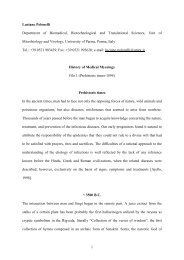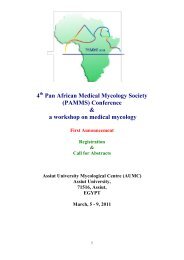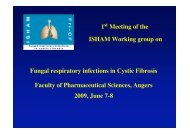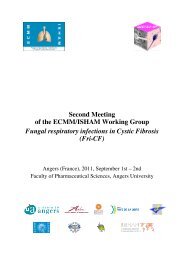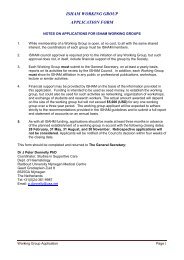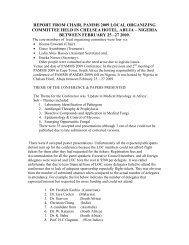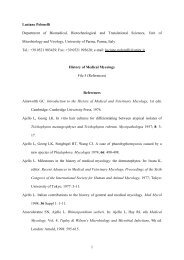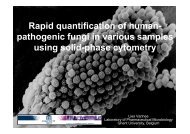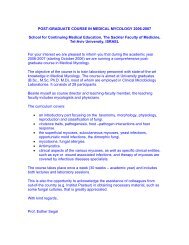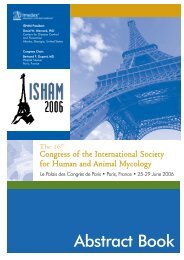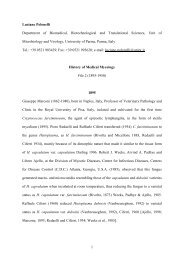4-31Transcriptional profile of Paracoccidioides brasiliensis induced by oenothein B, anantifungal agent from Brazilian Savannah plant Eugenia unifloraP. F. Zambuzzi 1 , Rezende, R. V. 1 , Borges, C. L. 1 ,Ferri, P. H. 2 , Santos, S. C. 2 , Soares, C. M. A. 1 and Pereira, M 11 Laboratório de Biologia Molecular, Instituto de Ciências Biológicas, Universidade Federal de Goiás, Goiania-GO-Brazil. 2 Laboratório deBioatividade Molecular, Instituto de Química, Universidade Federal de Goiás, Goiania-GO-Brazil. e-mail: mani@icb.ufg.brParacoccidioides brasiliensis is a soil-borne fungus and the causative agent of paracoccidioidomycosis, asystemic mycosis that cause chronic and progressive infection. The long-time treatment, the high toxicity of thedrugs, and the appearance of resistant or multi-resistant strains have imposed the need for a permanent searchand development of new therapeutic approaches. A large variety of compounds extracted from plants has beenused to the discovery of new antimicrobial agents. The active compound oenothein B, purified from leaves ofEugenia uniflora, a Brazilian Savannah plant, has been evaluated on the growth, viability and gene expressionof P. brasiliensis. That compound interferes with yeast cell morphology and inhibits glucana synthase transcriptsaccumulate; suggesting that oenothein B can be a good candidate to antifungal agent. Aiming elucidate themechanism of action of oenothein B on P. brasiliensis, was realized Representational Difference Analysis (RDA).P. brasiliensis yeast cells were grown on MMcM (Mc Veigh & Morton) medium in the presence (tester) and in theabsence (driver) of oenothein B for 90 min, at 37 o C. After extraction of total RNA, the cDNA was obtained andused to RDA experiments according with modified protocol previously described by Pastorian et al. (2000). RDAexperiment originated 280 ESTs that were successfully sequenced and originated 28 contig and 24 singlets. Usingthe BLATX program, was possible classified the ESTs in agreement with the functions. The analyses indicated thepresence of transcripts with functions related with cell wall and membrane, elongation and transcription factors andhypothetic proteins. The elucidation of the action mechanism of oenothein B will facilitate the design and synthesisof related compounds with enhanced pharmacological profiles.4-32Transcriptional profile of murine macrophages infected with pathogenic fungus HistoplasmacapsulatumSimoneide.S.S 1 , Passos-Silva. D. G. 2 ., Teixeira. S.M.R 2 , Junta, C. 3,4 , Medeiros. A. I. 6 , Silva. C. L. 5 , Faccioli. L. H. 6 , Passos.G.A.S. 3,4 , Felipe. M.S.S. 11Departamento de Biologia Celular, Universidade de Brasília, Brasília, DF, Brazil. 2 Departamento de Bioquímica e Imunologia, UFMG,Belo Horizonte, MG, Brazil. 3 Departamento de Genética, USP, Ribeirão Preto, SP, Brazil. 4 Faculdade de Odontologia, USP, RibeirãoPreto, SP, Brazil. 5 Faculdade de Medicina de Ribeirão Preto, USP, Ribeirão Preto 14040-900, SP, Brazil. 6 Faculdade de CiênciasFarmacêuticas, USP, Ribeirão Preto, SP, Brazile-mail: simoneide.silva@gmail.comHistoplasma capsulatum is the thermo-dimorphic fungus that causes histoplasmosis. The yeast form of P.brasiliensis acts as a facultative intracellular pathogen, being able to survive and replicate within macrophages asa probable mechanism to evade the immune system. In the present work the kinetic profile of murine macrophagesinfected with H. capsulatum was investigated. A clinical isolate of the fungus was used for macrophage infection.Total RNA from infected and non-infected macrophages at 6, 24 and 48 hours was extracted with the TRIzol ®reagent (Invitrogen, USA) and hybridized against glass arrays. After normalization, the Significance Analysis ofMicroarrays software (SAM- http://www-stat.standord.edu/) was used to assess the significant variations in geneexpression between experimental and control conditions. Genes were considered to be modulated if they crossedtwo statistical thresholds (q value
4-33Analysis and identification of three P. brasiliensis genes possibly implicated in virulenceO. Hernandez 1 , AM Garcia 1 A Restrepo 1 and JG McEwen 1,2 .1 Corporación para Investigaciones Biológicas, CIB, Medellín – Colombia. 2 Facultad de Medicina Universidad de Antioquia, Medellín– Colômbia. e-mail: orvillehr@hotmail.comIn general, fungal dimorphism is considered an essential trait for successful adaptation of pathogenic fungito the human host, and this ability that has been studied among different dimorphic fungi and characterizedby several physiological and structural modifications. P. brasiliensis conidia are consider to be the infectiousparticles which once inhaled into the lungs begin their morphological transition to the yeast phase. This processhas been previously studied, both morphologically and at the transcriptome level either during batch culturegrowth or in the infection process itself. Some of the major alterations described in the transcriptome profileduring the morphological switch include differential expression of genes involved in the rearrangement of cell wallcomposition, stress response and diverse metabolic pathways. Nonetheless, conidia-to-yeast transition remainsgreatly uncharacterized and, by this reason, it is important to analyze the relevance of specific proteins during suchprocess. Recently, the complete genome and the corresponding annotation of P. brasiliensis strain Pb 03 hasbeen published by the Broad Institute with 90% of all possibly proteins expressed by the fungus being incorporatedinto this genome. The aims of this work was to analyze some important gene sequences considered as virulencefactors in other fungi, such as: Glucan synthase, involved in the generation of beta-glucan, important in the cellwall -and an alternative oxidase, involved in the electron transport chain. The latter provides an alternative routefor electrons passing through the electron transport chain to reduce oxygen and glyceraldehide 3 phosphatedeshidrogenase (GAPDH), catalyzes the sixth step of glycolysis and serves thus to break down glucose for energyand carbon molecules. Based in the Pb 03 genome “in silico” analyses were made using the partial sequencesof the genes mentioned above; additionally, PCR primers were designed to amplify these genes in strain ATCC60855, and the PCR products were sequenced and compared with the database published by the Broad Institutein order to confirm their presence. Results: All the sequences corresponding to virulent genes searched for werefound with similar levels above 90% and e-value of 0.0 for all of them. The probability of these results being atrandom is near zero, confirming the existence of these genes in P brasiliensis. ClustalW analysis showed highsimilarity between the sequence of these genes in 60855 and Pb03 strains. These results made of these genessuitable targets for knockout–knockdown studies aimed at confirming their role in pathogenicity.4-34Internalization of magnetic nanoparticles by Paracoccidioides brasiliensis yeast cellsA.C. Amaral 1, 3 , Braun S. 1 , Nunes E.S. 4 , Bocca A.L. 1 , Lima E.C.D. 4 , Báo S.N. 1 , Azevedo R.B. 1 , de Morais P.C. 2 and Felipe M.S.S. 11Instituto de Ciências Biológicas e 2 Física, Universidade de Brasília, UnB, Brasília, Brazil. 3 Ciências Genômicas e Biotecnologia,Universidade Católica de Brasília, UCB, Brasília, Brazil. 4 Instituto de Química, Universidade Federal de Goiás, UFG, Goiânia, Brazil.e-mail: amaralandre@yahoo.com.brIntroduction and aim: Functionalized magnetic nanoparticles can be used for several applications in biology,such as cell labeling, isolation and purification of specific molecules or cells from a culture (J. Biosci. Bioeng.,100(1):1-11, 2005). When properly functionalized these nanoparticles, with average size between 3 and 20nm caneasily penetrate the cells. Once inside the cell, this magnetic nanoparticle can separate or drive the cell using anexternal magnetic field. Functionalization is possible by linear linker molecules with reactive organic groups at bothends. One group is attached to the nanoparticle surface and the other is used to link biocompatible molecules,antibodies, fluorophores, etc (J. Nanob., 2:3, 2004). Here we report the internalization of magnetic nanoparticlesby P. brasiliensis Pb18 yeast cells. Methods: To investigate the internalization of nanoparticles, the yeast cells(3 × 10 4 cells/mL) were incubated during 1, 4 and 8 hours in YPD medium containing maghemite nanoparticlesfunctionalized with dimercaptosuccinic acid (10 14 particles/mL), followed by routine techniques for transmissionelectron microscopy (TEM). To evaluate the toxicity, after the exposure times to magnetic particles 3 × 10 2 cells wereplated in BHI supplemented with 4% horse serum, 5% P. brasiliensis 192 culture filtrate and 40mg/L Gentamicin.The plates were incubated at 36 ºC and CFU was counted at 21 st day post-plating to asses the cell viability. Resultsand discussion: The TEM has revelead the uptake of magnetic nanoparticles by the P. brasiliensis Pb18 after4 and 8 hours of incubation. The majority of nanoparticles were found between the cell wall and the plasmaticmembrane, and a very small number were observed within the cytoplasm. These magnetic nanoparticle uptakesdid not interfere with the cell viability, once no differences on CFU between the treated groups and controls werenoted. These findings could be useful, for example, to accompaning the establishment of the paracoccidioidomycosisin animal model. Since the magnetic nanoparticles have the capability to be used as contrast agents in magneticresonance imaging (J. Biosci. Bioeng., 100(1):1-11, 2005), animals can be infected with P. brasiliensis containing thenanoparticles to investigate the kinectic of the fungal infection. Financial support: CNPq.181



